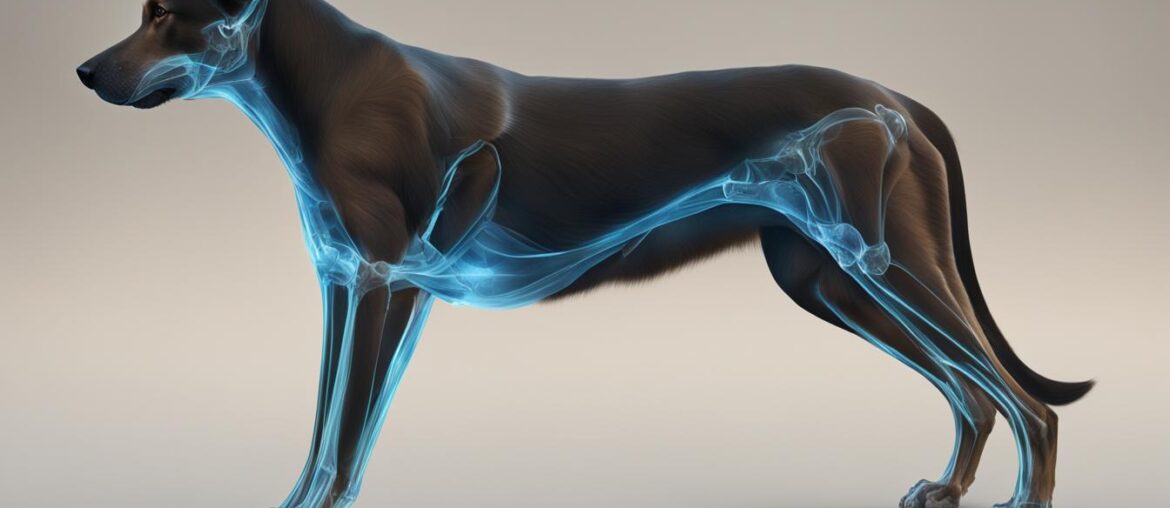As a professional journalist specializing in animal anatomy, I often receive questions from curious pet owners. One question that frequently comes up is, “Do dogs have knees?” The answer is yes, although the technical term for their knee joint is a stifle joint. In this article, I will explore the fascinating anatomy of a dog’s leg and delve into the specifics of their knee structure.
Key Takeaways:
- Dogs have knee joints, technically known as stifle joints, which connect their thigh bone (femur) to the lower leg bones (tibia and fibula).
- The kneecap in dogs is called the patella, and it functions similarly to the human kneecap.
- Dogs can experience various knee problems, including torn ligaments and arthritis, which can cause pain and reduced mobility.
- Understanding the structure of a dog’s leg joints is crucial for recognizing and addressing potential leg-related health concerns.
- Regular vet visits and proactive care are essential for maintaining a dog’s leg health and overall well-being.
Dog Leg Anatomy
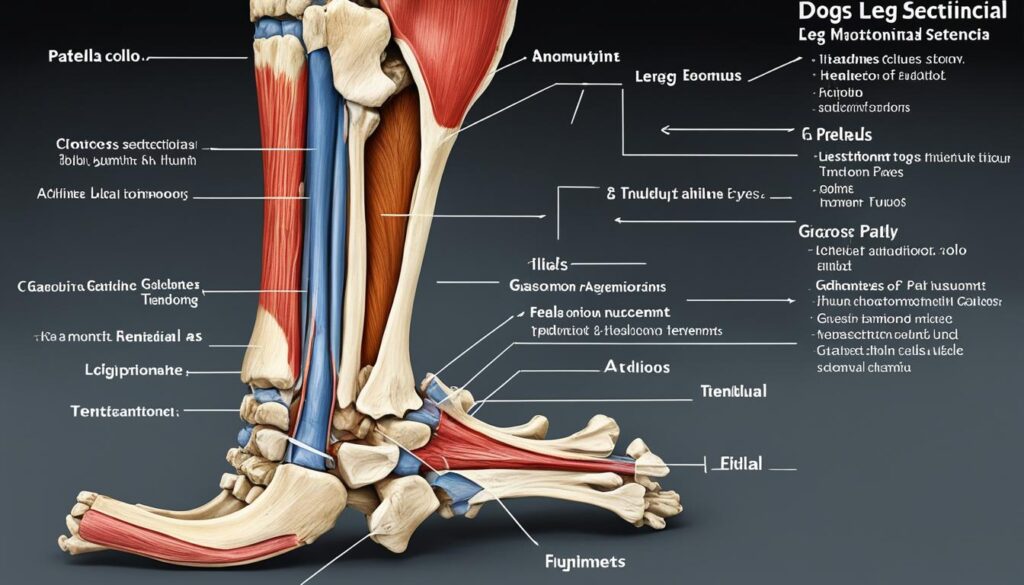
Dog leg anatomy is complex, especially when it comes to the knees or stifle joints found in the hind legs. These joints play a crucial role in the overall structure and movement of a dog’s leg. Understanding the anatomy of a dog’s leg is essential for dog owners to communicate effectively with veterinarians about any potential leg-related health concerns.
The stifle joint is the equivalent of the human knee joint in dogs. It connects the femur (thigh bone) to the tibia and fibula (lower leg bones) through a complex network of ligaments, tendons, and muscles. The patella, also known as the kneecap, is situated within this joint and acts as a protective shield for the joint.
When it comes to the front legs, which are also known as forelegs, dogs have elbows and wrists that serve as the equivalent of human arm joints. The forelegs consist of the radius and ulna bones, with the carpus being the equivalent of the wrist in dogs.
Understanding the different parts of a dog’s leg anatomy, including the stifle joint and forelegs, can help dog owners better comprehend the structure of their dog’s limbs and communicate effectively with veterinarians. This knowledge is particularly valuable when discussing potential leg-related health concerns and seeking appropriate treatment options.
Joint Anatomy in Dogs
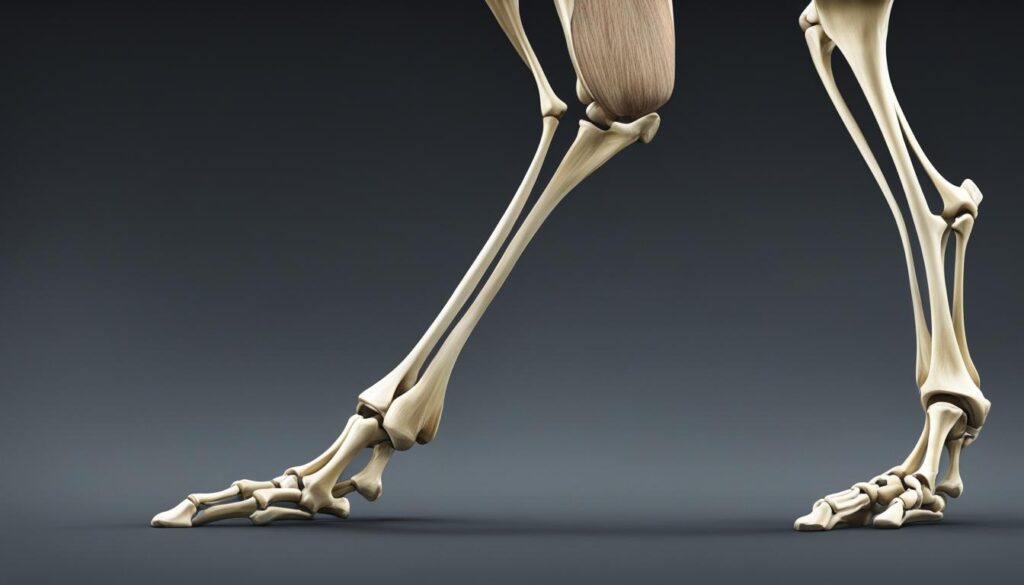
Dogs have various types of joints in their bodies, each serving a unique purpose and providing different degrees of movement and stability. Understanding the anatomy of these joints is crucial for recognizing and addressing joint-related health issues in dogs.
Synovial Joints
Synovial joints are the most common type of joint found in dogs. These joints, which include the knee joint, provide the greatest range of motion and flexibility. They are enclosed by a joint capsule and lined with synovial fluid, which lubricates the joint and reduces friction during movement. Synovial joints allow dogs to perform a wide range of activities, including running, jumping, and playing.
Fibrous Joints
Fibrous joints are joints that allow very little movement and are characterized by the presence of thick, fibrous connective tissue. These joints are commonly found in the skull of dogs and play a crucial role in providing structural stability and protecting the brain. The fibrous nature of these joints helps to prevent excessive movement, ensuring the integrity of the skull and protecting vital organs.
Cartilage Joints
Cartilage joints are formed when two or more bones are connected by cartilage, a flexible yet resilient type of connective tissue. These joints allow for some degree of movement, providing both stability and flexibility. Cartilage joints are found in various parts of a dog’s body, including the ribs, spine, and certain joints in the limbs. These joints absorb shock, distribute forces evenly, and contribute to smooth movement.
By understanding the different types of joints in dogs, including synovial joints, fibrous joints, and cartilage joints, dog owners can better recognize and address joint-related health issues. Maintaining the health and functionality of these joints is crucial for ensuring a dog’s overall well-being and quality of life.
Knee Problems in Dogs
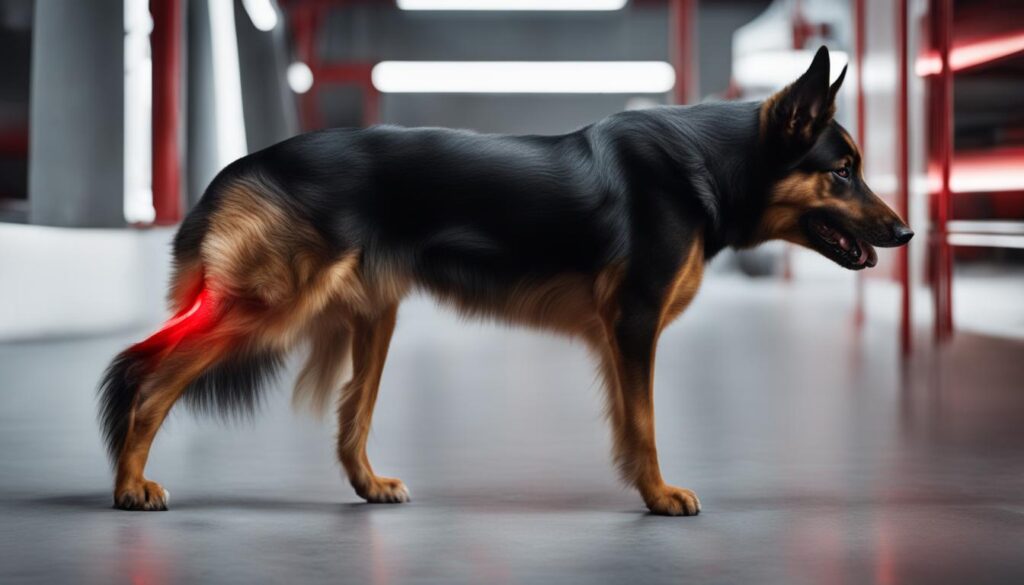
Knee problems are common in dogs and can be caused by various factors, including arthritis and torn ligaments. Arthritis is the inflammation of the joints, leading to pain and restricted movement. Older dogs are more susceptible to arthritis due to wear and tear on the cartilage. Torn ligaments, specifically the cruciate ligaments, can also cause knee problems in dogs and often lead to a ruptured meniscus. These knee issues can result in chronic pain and mobility issues for dogs. Proper diagnosis and treatment by a licensed veterinarian are crucial for managing and addressing knee problems in dogs.
Arthritis is a common knee problem in dogs, causing inflammation, pain, and restricted movement in the joints. As dogs age, the cartilage that cushions their knee joints wears down, leading to arthritis. This condition can be debilitating and greatly impact a dog’s quality of life. Symptoms of dog knee arthritis include limping, stiffness, reluctance to move, and difficulty standing up. It is important for pet owners to watch for these signs and seek veterinary care if arthritis is suspected.
Symptoms of Dog Knee Arthritis:
- Limping or favoring one leg
- Stiffness
- Reluctance to move or exercise
- Pain or tenderness when the affected leg is touched
- Swelling or heat around the knee joint
Proper diagnosis of dog knee arthritis is essential for developing an effective treatment plan and managing the condition. Veterinarians can perform a physical examination, X-rays, and other diagnostic tests to confirm arthritis and rule out other potential causes of knee problems. Treatment options may include medication, physical therapy, weight management, and supplements to support joint health.
Torn ligaments in dogs, particularly the cranial cruciate ligament (CCL), are another common cause of knee problems. The CCL is responsible for stabilizing the knee joint, and when it tears, it can lead to pain, instability, and difficulty bearing weight on the affected leg. Torn ligaments often occur due to sudden twists or trauma, but they can also be a result of gradual degeneration over time.
Symptoms of Torn Ligaments in Dogs:
- Lameness or limping
- Inability to bear weight on the affected leg
- Swelling or heat around the knee joint
- Pain or tenderness when the affected leg is touched
- Difficulty rising or climbing stairs
Treatment for torn ligaments in dogs may involve conservative management, such as rest, anti-inflammatory medication, and physical therapy. In more severe cases, surgery may be necessary to repair or reconstruct the torn ligament and restore stability to the knee joint. It is important to consult with a veterinarian to determine the most appropriate treatment approach based on the individual dog’s condition and lifestyle.
Common Knee Problems in Dogs
| Knee Problem | Symptoms | Treatment |
|---|---|---|
| Arthritis | Limping, stiffness, pain, swelling | Medication, physical therapy, weight management, supplements |
| Torn Ligaments | Lameness, difficulty bearing weight, swelling, pain | Conservative management, surgery |
| Ruptured Meniscus | Lameness, swelling, pain, joint instability | Surgery, pain management, rehabilitation |
Surgery for Knee Problems in Dogs

In some cases, surgery may be necessary to address knee problems in dogs. Canine knee surgery can be performed under general anesthesia and is often successful in treating conditions such as osteoarthritis and removing tumors. Surgeons have developed various surgical techniques to repair and stabilize the knees of dogs, depending on the specific condition and severity of the problem.
When considering knee surgery for a dog, it is essential to consult with a veterinarian who specializes in orthopedic surgeries for animals. The veterinarian will assess the dog’s overall health, conduct a thorough examination of the knee, and recommend the most appropriate surgical procedure.
While surgery can be effective in addressing knee problems, it is important to understand that it can be expensive and carries certain risks. Anesthesia, post-operative care, and rehabilitation are crucial parts of the surgical process and require commitment from the dog owner. Additionally, surgical intervention should be considered only when other treatment options have been exhausted or are not sufficient to alleviate the dog’s chronic pain or mobility issues.
Surgery for knee problems in dogs should be approached as a last resort, after careful consideration of the potential risks and benefits. It is a decision that should be made in consultation with a veterinarian, who will evaluate the dog’s individual circumstances and recommend the most appropriate course of action.
In cases where surgery is deemed necessary, here are some common knee surgery options for dogs:
- Tibial Plateau Leveling Osteotomy (TPLO): This procedure involves restructuring the bones of the knee to stabilize the joint and reduce stress on damaged ligaments. It is commonly used to treat cranial cruciate ligament (CCL) tears and is known for its high success rate.
- Tightrope Procedure: The Tightrope procedure involves the placement of a synthetic ligament-like material to stabilize the knee joint. It is a less invasive alternative to traditional surgical methods and is often used to address CCL tears.
- Medial Patellar Luxation Correction: This surgery is performed to correct a misaligned kneecap. The surgeon will realign the patella and reconstruct the supporting structures to prevent further luxation.
- Arthroscopy: Arthroscopy is a minimally invasive surgical technique that uses a small camera and specialized instruments to treat various knee problems, such as removing bone fragments, smoothing rough joint surfaces, or repairing damaged cartilage.
It is important to note that the choice of surgery depends on the specific condition and needs of the dog. Close monitoring and post-operative care, including physical therapy, will be necessary for the dog’s full recovery and rehabilitation.
| Surgical Procedure | Description |
|---|---|
| Tibial Plateau Leveling Osteotomy (TPLO) | A procedure that involves restructuring the bones of the knee to stabilize the joint and reduce stress on damaged ligaments. Commonly used to treat cranial cruciate ligament (CCL) tears. |
| Tightrope Procedure | The placement of a synthetic ligament-like material to stabilize the knee joint. It is a less invasive alternative to traditional surgical methods and often used to address CCL tears. |
| Medial Patellar Luxation Correction | Surgery performed to correct a misaligned kneecap. The surgeon realigns the patella and reconstructs the supporting structures to prevent further luxation. |
| Arthroscopy | A minimally invasive surgical technique that uses a small camera and specialized instruments to treat various knee problems, such as removing bone fragments, smoothing rough joint surfaces, or repairing damaged cartilage. |
Dogs and Arthritis

Dogs, like humans, can develop arthritis as they age.
According to estimates, more than half of all dogs over seven years old develop some degree of osteoarthritis (OA).
Canine osteoarthritis affects the cartilage within the joints, including the knees, resulting in pain and restricted movement.
Risk factors for arthritis in dogs include obesity and hereditary factors such as breed predisposition or genetic defects.
Proper weight management, exercise, and medication can help manage arthritis in dogs and improve their quality of life.
Here are some tips for managing arthritis in dogs:
- Keep your dog’s weight within a healthy range to reduce stress on their joints.
- Provide regular, low-impact exercise to keep their joints mobile and muscles strong.
- Consider incorporating joint supplements into their diet, under the guidance of a veterinarian.
- Use non-steroidal anti-inflammatory drugs (NSAIDs) or other prescribed medications to alleviate pain and inflammation.
It is important to consult with a veterinarian to develop a personalized arthritis treatment plan for your dog.
Managing Arthritis in Dogs: A Case Study
Let’s take a look at how proper arthritis management improved the life of Max, a 10-year-old Golden Retriever.
“Before starting treatment, Max struggled to climb stairs and was hesitant to go on walks. He would often limp and seemed reluctant to engage in any physical activity. After consulting with our veterinarian and following a tailored treatment plan that included weight management, regular exercise, and medication, we noticed a significant improvement in Max’s mobility and overall well-being. He now enjoys daily walks, runs up the stairs effortlessly, and is back to his playful self. Managing Max’s arthritis has made a world of difference for him and our family.”
Importance of Regular Vet Visits
Regular visits to a licensed veterinarian are essential for maintaining a dog’s overall health, including their leg health. During vet visits, the veterinarian can perform leg health examinations, assess any potential issues, and provide preventive care.
Early detection and intervention can help prevent or manage leg-related health problems in dogs. It is important for dog owners to communicate any concerns or observations about their dog’s leg health during these visits and follow any recommended treatments or preventive measures.
By scheduling regular vet visits and prioritizing preventive care, dog owners can ensure that their furry companions receive the necessary attention and monitoring to maintain optimal leg health.
Dog Leg Injuries and Symptoms
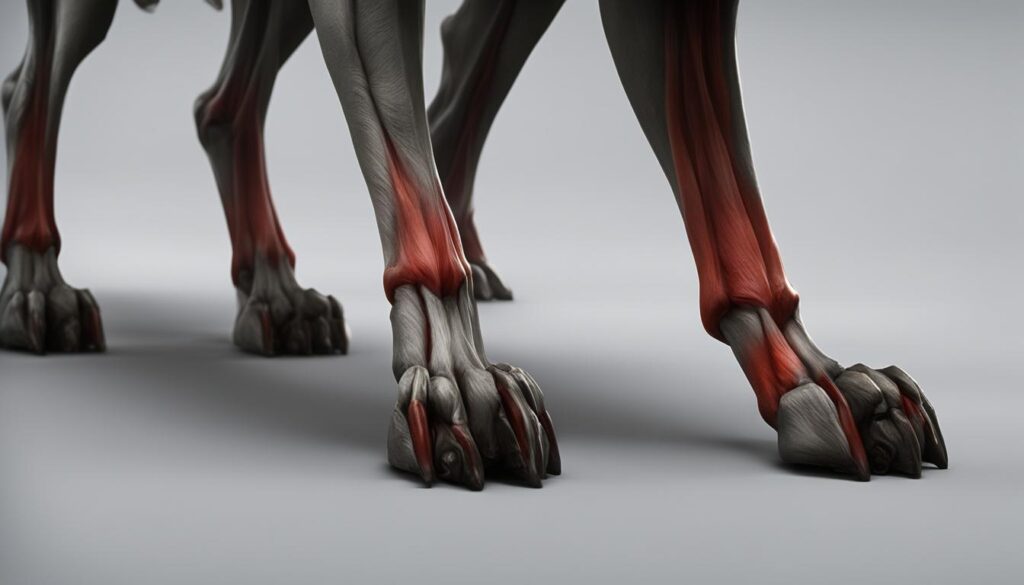
Dogs are prone to various leg injuries, including ligament tears, fractures, and joint instability. It is essential for dog owners to be vigilant and recognize the signs of leg injuries in their canine companions. Prompt identification and treatment can prevent further complications and promote a faster recovery. Some common signs of leg injuries in dogs include:
- Limping or favoring one leg
- Weakened or unstable leg
- Swelling or inflammation
- Holding up the paw
- Licking or biting at the affected area
If you notice any of these symptoms in your dog, it is crucial to seek veterinary attention. A licensed veterinarian can evaluate the extent of the leg injury and recommend appropriate treatment options. Ignoring or delaying treatment can lead to further complications and prolong your dog’s discomfort.
| Common Leg Injuries in Dogs | Symptoms |
|---|---|
| Ligament Tears (ACL) | – Sudden onset of lameness – Difficulty getting up or walking – Swelling around the knee – Pain when extending or flexing the leg |
| Fractures (Broken Bones) | – Obvious deformity or misalignment – Swelling and bruising around the affected area – Pain or sensitivity to touch – Reluctance to put weight on the leg |
| Joint Instability (Luxating Patella) | – Intermittent or persistent lameness – ‘Skipping’ or ‘bunny hopping’ gait – Audible clicking or popping sound from the knee – Pain or discomfort when the knee locks or extends |
Timely diagnosis and treatment of leg injuries can make a significant difference in your dog’s overall recovery and quality of life. Always consult with a trusted veterinarian for proper evaluation and guidance when your dog experiences leg-related issues.
Wrapping Up
Understanding the structure and anatomy of a dog’s legs, including the knees, is crucial for recognizing and addressing potential leg-related health concerns. Dogs can experience various knee problems, such as arthritis and torn ligaments, which can result in pain and reduced mobility. To ensure a dog’s leg health, regular vet visits and proactive care are essential.
While surgical options may be available to address severe knee issues, it is important to carefully consider the risks and costs involved. By staying attentive to their dog’s leg health, dog owners can ensure the overall well-being and comfort of their furry companions.
If you have any questions or concerns about your own dog’s knee health, it is always advisable to consult with a licensed veterinarian. They can provide personalized advice and guidance to help you manage your dog’s leg care effectively.
FAQ
Do dogs have knees?
Yes, dogs have knees. Although technically called stifle joints, they serve the same function as knees in humans.
What is the structure of a dog’s leg joints?
A dog’s leg joints consist of the stifle joint in the hind legs, which connects the femur to the tibia and fibula. The front legs have elbows and wrists, which are equivalent to the human arm joints.
What types of joints do dogs have?
Dogs have synovial joints, fibrous joints, and cartilage joints. Synovial joints, including the knee joint, have the greatest range of motion. Fibrous joints allow very little movement, and cartilage joints allow some movement, formed when two or more bones are joined by cartilage.
What are common knee problems in dogs?
Common knee problems in dogs include arthritis and torn ligaments. Arthritis is the inflammation of the joints, leading to pain and restricted movement. Torn ligaments, especially the cruciate ligaments, can cause knee instability and chronic pain.
Is surgery necessary for treating knee problems in dogs?
In some cases, surgery may be necessary to address severe knee problems in dogs. It is usually considered when other treatment options have been exhausted and the dog experiences chronic pain or mobility issues that cannot be managed with medication alone.
Can dogs develop arthritis?
Yes, dogs can develop arthritis, especially as they age. More than half of all dogs over seven years old are estimated to develop some degree of osteoarthritis. Proper weight management, exercise, and medication can help manage arthritis in dogs.
Why are regular vet visits important for a dog’s leg health?
Regular vet visits are essential for maintaining a dog’s overall health, including their leg health. During these visits, vets can perform leg health examinations, identify any potential issues, and provide preventive care to ensure early detection and intervention.
What are the signs of leg injuries in dogs?
Signs of leg injuries in dogs may include limping, weakness in the leg, swelling, holding up the paw, or licking at the affected area. Dog owners should seek veterinary attention if they notice any signs of leg injuries or discomfort.
How can I recognize and manage knee problems in my dog?
Understanding the structure and anatomy of a dog’s legs is important for recognizing and addressing potential leg-related health concerns. Regular vet visits, proactive care, and open communication with your vet can help ensure your dog’s overall well-being and comfort.


